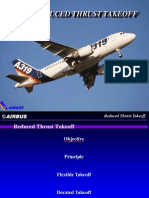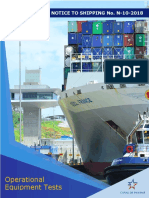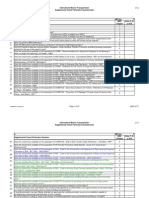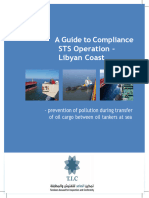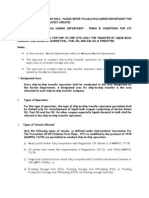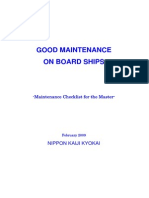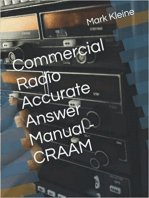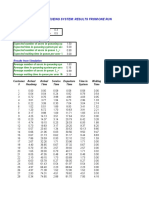100%(1)100% found this document useful (1 vote)
49 viewsFleet Notice 119
Fleet Notice 119
Uploaded by
GeorgeThis document provides summaries of various procedures, regulations, and information for yachts:
1. It outlines the procedures for incident reporting, including contact information for the 24/7 global response center and expectations for follow up.
2. It reminds yachts of requirements regarding garbage management plans for vessels over 100GT and record books for vessels over 400GT, and designating responsible persons.
3. It summarizes various regulatory updates and guidance from classification societies regarding automatic sprinkler systems, reducing port state control detentions, ECDIS compliance for Australian ports, noise and vibration requirements, and regulations for operating personal watercraft in French waters.
Copyright:
© All Rights Reserved
Available Formats
Download as PDF, TXT or read online from Scribd
Fleet Notice 119
Fleet Notice 119
Uploaded by
George100%(1)100% found this document useful (1 vote)
49 views2 pagesThis document provides summaries of various procedures, regulations, and information for yachts:
1. It outlines the procedures for incident reporting, including contact information for the 24/7 global response center and expectations for follow up.
2. It reminds yachts of requirements regarding garbage management plans for vessels over 100GT and record books for vessels over 400GT, and designating responsible persons.
3. It summarizes various regulatory updates and guidance from classification societies regarding automatic sprinkler systems, reducing port state control detentions, ECDIS compliance for Australian ports, noise and vibration requirements, and regulations for operating personal watercraft in French waters.
Original Description:
Regulations in MLC2006
Copyright
© © All Rights Reserved
Available Formats
PDF, TXT or read online from Scribd
Share this document
Did you find this document useful?
Is this content inappropriate?
This document provides summaries of various procedures, regulations, and information for yachts:
1. It outlines the procedures for incident reporting, including contact information for the 24/7 global response center and expectations for follow up.
2. It reminds yachts of requirements regarding garbage management plans for vessels over 100GT and record books for vessels over 400GT, and designating responsible persons.
3. It summarizes various regulatory updates and guidance from classification societies regarding automatic sprinkler systems, reducing port state control detentions, ECDIS compliance for Australian ports, noise and vibration requirements, and regulations for operating personal watercraft in French waters.
Copyright:
© All Rights Reserved
Available Formats
Download as PDF, TXT or read online from Scribd
Download as pdf or txt
100%(1)100% found this document useful (1 vote)
49 views2 pagesFleet Notice 119
Fleet Notice 119
Uploaded by
GeorgeThis document provides summaries of various procedures, regulations, and information for yachts:
1. It outlines the procedures for incident reporting, including contact information for the 24/7 global response center and expectations for follow up.
2. It reminds yachts of requirements regarding garbage management plans for vessels over 100GT and record books for vessels over 400GT, and designating responsible persons.
3. It summarizes various regulatory updates and guidance from classification societies regarding automatic sprinkler systems, reducing port state control detentions, ECDIS compliance for Australian ports, noise and vibration requirements, and regulations for operating personal watercraft in French waters.
Copyright:
© All Rights Reserved
Available Formats
Download as PDF, TXT or read online from Scribd
Download as pdf or txt
You are on page 1of 2
N 119 26TH JULY 2016
HILLROB PROCEDURES, PEOPLE & ROLES
Incident Reporting: ANYTIME / ANY EVENT / ANY DOUBT
The 24/7 HR Global Response Centre number is found on the Safety &
Environment Policy, which should be displayed onboard and known to
all crew:
+1 480 333 3874
The call centre agent will take details of the incident and immediately
contact the DPA on duty. Yachts should expect a call back from DPA
or HR Office within 10 minutes (even at 2am!). The emergency
response team will be on standby to provide assistance as required.
Garbage Management Plans: implementation of GMP on yachts
>100GT. As per recent Flag States survey observations; a review of
GMP amongst the fleet will be carried out to ensure compliance with
IMO Resolution MEPC.220 (63), which can be found here on HR Click.
Reminder: Yachts >100GT must carry a GMP, Yachts >400GT must
also carry a Garbage Record Book. A Responsible person on-board
must be designated
ISM / FLAG STATE /CLASS INFORMATION
LR 20/2016 Statutory Alert: Revised Guidelines for maintenance and
inspection of automatic sprinkler system reissue Class News:
Refer to IMO circ MSC.1/Circ.1516 , for in-service testing of automatic
sprinkler and automatic water mist systems, following failures that
have been identified on both high and low pressure systems.
Concerns automatic sprinkler heads or automatic water mist heads
(glass bulb actuators), advises to actively monitor and assess
effectiveness of these systems on a planned periodical basis:
Water quality should be recorded and maintained in
accordance with Manufacturer guidelines
Quarterly testing and inspection should now include water
mist, water spray and sprinkler systems water quality
Instead of annual functional testing of a minimum of 2 sprinkler
or water mist nozzles, a new test regime has been included to
ensure that all different types of sprinkler heads and nozzles
are tested. The results of the initial tests can lead to extended
testing
When testing using the new flow chart regime, water quality
testing should be conducted in each corresponding piping
section
Sprinkler system functional testing should only be carried out
by personnel capable of ensuring the system is fully charged
and operational after the testing, which will normally be the
Manufacturer.
Sprinkler functional testing is to be witnessed by a surveyor,
preferably at the same time as the Passenger ship or Cargo
ship safety survey.
ABS 19/05/2016 Guidance for Reducing Port State Control
Detentions - Refer to www.eagle.org /rules and resources
Provides Shipowners and ship crews with the latest updated information
for maintaining compliance with current Port State control regimes in a
mobile-friendly and interactive format.
The guide is intended to be used with normal pre-port arrival and
departure checks required by international regulations, as well as in
conjunction with onboard routine maintenance programs. The items in
this guide have been identified as top PSC detention items on data
gathered by ABS-classed vessels.
AMSA MN 08/2016
CISR GN 2016-03-ECDIS
ECDIS as a primary means of navigation and passage planning, for
vessels calling at Australian Ports.
Port state control inspectors will focus on how ships meet the SOLAS
requirements for chart carriage and the safe and effective conduct of
navigation tasks:
Appropriate declaration of ECDIS equipment in the Record of
Equipment for Cargo Ship or Passenger ship (From E or Form
P)
Listing of ECDIS as critical equipment in the SMS
Documented procedures and instructions for the use of ECDIS
in the SMS and all understood by OOW
ECDIS type approval certification confirming compliance with
relevant IMO performance standards and IEC test standard.
ECDIS software is maintained to the latest applicable IHO
standards
Use of latest edition official ENCs, updated and corrected to
the latest available updates and notices to mariners
Adequate independent back-up arrangements (as detailed on
the Record of Equipment) ensuring safe navigation for the
remainder of the voyage in the event of an ECDIS failure
Approved ECDIS generic and familiarisation training for master
and officers on the navigational watch.
Conformance and alignment with input form sensors and
presentation of such information on ECDIS display
Evident of periodic tests and checks as per SMS
Demonstration of operational competency by the ships
navigation officers
ECDIS settings are appropriate to the ships dimensions and
area of operations.
YACHTS are kindly requested to verify their ECDIS equipment
compliance and documentation, and identify any discrepancy for further
training or support. Other Flag states might soon follow the path of AMSA
regarding PSC items surveyed.
Page 1 of 1
N 119 26TH JULY 2016
MLC2006 Noise and Vibrations requirements:
Refer : DNV-GL rules for classification and construction on HRClick
here.
Recent Flag state surveys raised observations on the absence aboard
yachts of the Noise and Vibrations Survey report, which is a
requirement as per MLC2006. This report should be delivered at
construction or re-issued after major alterations of the vessel.
YACHTS are kindly requested to verify that they hold a Noise and
Vibration Survey report, compliant with the levels required and if such
survey has been carried out after major refit.
COUNTRY SPECIFIC INFORMATION
France For the use of Jetskis and Wave runners in French
Territorial waters. Refer to French Administration regulations on
Vhicules Nautiques a moteur here (in French)
Drivers age and licence: the driver must be over 16 years old
and holding a licence for nautical vehicle >4.5kW. This licence
is not necessary if the driver is supervised by competent and
certified crew (including Captain for yachts over 24m) (RYAPWC is recognised as compliant).
Distance to shore: driving a jetski within 300meters from the
shore is prohibited, unless within the appropriate approach
channels, where speed is limited to 5kts.
Safe distance to shelter:
=> 1-person jetskis cannot navigate further than 2 NM from
shelter.
=> 2-persons wave-runners cannot navigate further than 6NM
from shelter.
Night navigation is prohibited.
Safety Equipment: => up to 2NM
o PFD or lifejacket
o Mean of light signal on PFD or held by each persons
o Towing line or system, attached to the vehicle
Up to 6NM: in addition to above:
o Kill cord or equivalent system
o VHF radio
o 3 hand flares
o Magnetic compass or GPS
o Charts and Colregs
Police and French Coast Guards can proceed with arrests at any time, if
they consider the driver or the vehicle to be in breach with above
requirements. Repeat offences will result in prosecution
Page 1 of 1
You might also like
- Chevron Vetting RequirementsDocument2 pagesChevron Vetting Requirementsady sto100% (2)
- Bnwas ManualDocument72 pagesBnwas ManualBhavin DoshiNo ratings yet
- Singapore Coc-1 Master Oral PreparationDocument195 pagesSingapore Coc-1 Master Oral Preparationcaptainkhan1977100% (14)
- British-Airways e A4Document14 pagesBritish-Airways e A4Samuel Lim70% (10)
- First Article Inspection (FAI) AS9102 PresentationDocument28 pagesFirst Article Inspection (FAI) AS9102 PresentationignaunaqNo ratings yet
- Marine Department - MCVS&RDocument5 pagesMarine Department - MCVS&REliza's Soothing Sounds100% (1)
- Class NK Good Maintenance Onboard ShipsDocument74 pagesClass NK Good Maintenance Onboard Shipsiacovosf836100% (3)
- Annexure-4 Checklist For The General Inspection of Indian Flag VesselsDocument13 pagesAnnexure-4 Checklist For The General Inspection of Indian Flag Vesselsveronica0% (1)
- Workboat Operation ProceduresDocument21 pagesWorkboat Operation ProceduresRicky Chua Snr100% (1)
- FAR-AMT 2021: Federal Aviation Regulations for Aviation Maintenance TechniciansFrom EverandFAR-AMT 2021: Federal Aviation Regulations for Aviation Maintenance TechniciansRating: 5 out of 5 stars5/5 (2)
- EDE Reduced Thrust TOFFDocument73 pagesEDE Reduced Thrust TOFFKunal HindujaNo ratings yet
- Malta Commercial Yatch Code 2015Document135 pagesMalta Commercial Yatch Code 2015tariktunad100% (1)
- REPSOL Marine Safety Criteria 2014 tcm11-689922 PDFDocument5 pagesREPSOL Marine Safety Criteria 2014 tcm11-689922 PDFjuricic2No ratings yet
- OCIMF Offshore Vessel Inspection Questionnaire (3rd Edition - Remote)Document130 pagesOCIMF Offshore Vessel Inspection Questionnaire (3rd Edition - Remote)Charalampos ChatzivasileiouNo ratings yet
- Panama Canal Requirements N10-2018Document11 pagesPanama Canal Requirements N10-2018Anca Geanina100% (1)
- Minimum Criteria For Vessels Navigating in The Romanian WatersDocument12 pagesMinimum Criteria For Vessels Navigating in The Romanian WatersAndrei StanescuNo ratings yet
- 15 VIQ With Regard To ECDISDocument39 pages15 VIQ With Regard To ECDISJoel Cargo100% (1)
- Questions For Interview - ANSWEREDDocument4 pagesQuestions For Interview - ANSWEREDalbaraka.shippingNo ratings yet
- FSI Checklist (May 2011)Document13 pagesFSI Checklist (May 2011)Arun Mishra67% (3)
- Maritime and Port Authority of Singapore: Shipping Circular No. 25 OF 2015Document3 pagesMaritime and Port Authority of Singapore: Shipping Circular No. 25 OF 2015Panikos ChrisNo ratings yet
- Repsol Vetting Procedures 2009Document17 pagesRepsol Vetting Procedures 2009Shaun Bardon-SpenceNo ratings yet
- Imo MSC Circular 1222 - SVDRDocument6 pagesImo MSC Circular 1222 - SVDRcaominhcuongNo ratings yet
- MARPOL A5 Checklist 2ppDocument2 pagesMARPOL A5 Checklist 2ppAhmad Aslam MohamadNo ratings yet
- Shipowners Club Reactivation of Vessels After A Period of Layup 2017 - 08 PDFDocument4 pagesShipowners Club Reactivation of Vessels After A Period of Layup 2017 - 08 PDFToheid AsadiNo ratings yet
- TURK LOYDU PORT STATE CONTROL PREPARATION CHECKLISTDocument28 pagesTURK LOYDU PORT STATE CONTROL PREPARATION CHECKLISTOguz GundogduNo ratings yet
- Solas Marpol AmendmentsDocument10 pagesSolas Marpol Amendmentshajee2076No ratings yet
- Minimmun Safety CriteriaDocument9 pagesMinimmun Safety CriteriaJavierContiNo ratings yet
- N10-2024-Operational-Equipment-1Document14 pagesN10-2024-Operational-Equipment-1Igor SorokaNo ratings yet
- Solas 111Document49 pagesSolas 111Anoop Anandan Payyappilly100% (2)
- Long Range Identification and Tracking of ShipsDocument3 pagesLong Range Identification and Tracking of ShipsAnıl KahyaNo ratings yet
- Repsol VettingDocument17 pagesRepsol VettingBtwins123No ratings yet
- ExxonMobil VPQ Review Form1Document27 pagesExxonMobil VPQ Review Form1qualiman1No ratings yet
- 2020 002 AMSA Pre Arrival CkecklistDocument6 pages2020 002 AMSA Pre Arrival Ckecklistdominic dmelloNo ratings yet
- Liferafts: Technical Publication Technical PublicationDocument9 pagesLiferafts: Technical Publication Technical PublicationAlaa Eldin MohamedNo ratings yet
- SPM Operational LimitationsDocument5 pagesSPM Operational LimitationshabibmusthafaNo ratings yet
- Control Operation and Care For Persons Mu-Bsc Prevzzz-ImpDocument51 pagesControl Operation and Care For Persons Mu-Bsc Prevzzz-Impsgodofthunders17No ratings yet
- DW2 Module 11 (Week 12)Document45 pagesDW2 Module 11 (Week 12)Frednixen GapoyNo ratings yet
- STS by TamkeenDocument10 pagesSTS by TamkeenAhmed AlmesurateNo ratings yet
- Towage Planning and Notification RequirementsDocument5 pagesTowage Planning and Notification RequirementsSeaworks CompanyNo ratings yet
- Guide Line N Check List For Cargo ShipDocument47 pagesGuide Line N Check List For Cargo ShipGansh100% (2)
- DF0LR34 - Bridge WatchkeepingDocument12 pagesDF0LR34 - Bridge WatchkeepingEdvin EdwNo ratings yet
- MOM App NavigationDocument10 pagesMOM App NavigationCristel_DCNo ratings yet
- MGN 272 (M) : Voyage Data Recorder'S (VDRS) - Performance TestingDocument6 pagesMGN 272 (M) : Voyage Data Recorder'S (VDRS) - Performance Testingaakash9090No ratings yet
- STS Extract From MarineDocument7 pagesSTS Extract From MarineWirote Archeepkosol100% (1)
- CHAPTER 2Document13 pagesCHAPTER 2kuchkiesNo ratings yet
- SHIPPING-CIRCULAR-No. 6 of 2024 - ISSUANCE OF DISPENSATION BY RECOGNISED ORGANISATIONS (ROs) 10.06.2024Document10 pagesSHIPPING-CIRCULAR-No. 6 of 2024 - ISSUANCE OF DISPENSATION BY RECOGNISED ORGANISATIONS (ROs) 10.06.2024swisscopearlNo ratings yet
- Guntan - Assignment No. 15 (SHP 303)Document5 pagesGuntan - Assignment No. 15 (SHP 303)Dimasalang PerezNo ratings yet
- Marine Safety Criteria For RepsolDocument4 pagesMarine Safety Criteria For Repsolnozerbhathena100% (1)
- Omv - Minimum Selecting CriteriaDocument6 pagesOmv - Minimum Selecting CriteriaerdemNo ratings yet
- NAV 327 Midterm WK 2Document28 pagesNAV 327 Midterm WK 2Berly FreemanNo ratings yet
- Port State Control - Information Notice No. 4 of 2011Document2 pagesPort State Control - Information Notice No. 4 of 2011RUBEN FERNANDESNo ratings yet
- 016 Servicing and Testing of LSA & Guidance On F-F Lifeboats and FPD'sDocument7 pages016 Servicing and Testing of LSA & Guidance On F-F Lifeboats and FPD'sduthindaraNo ratings yet
- 4-3 MMC-380-17-02-2022Document8 pages4-3 MMC-380-17-02-2022memoNo ratings yet
- NAV 3 Lesson 5 Keeping A LogDocument8 pagesNAV 3 Lesson 5 Keeping A LogMico Santos100% (1)
- NK Good Maintenance On Board Ships eDocument74 pagesNK Good Maintenance On Board Ships eArdyas Wisnu Baskoro100% (6)
- Smart 10 EcdisDocument5 pagesSmart 10 EcdisAnamaria Daniela100% (1)
- Risk Awareness Collision March 2020 WEBDocument30 pagesRisk Awareness Collision March 2020 WEBCan Yigit Dinc100% (1)
- The Main Responsibilities of Ship Security Officer (SSO) AreDocument8 pagesThe Main Responsibilities of Ship Security Officer (SSO) AreJayesh SolaskarNo ratings yet
- Marine Radio Operator Permit Manual: Pass Your Marine Operator Permit ExamFrom EverandMarine Radio Operator Permit Manual: Pass Your Marine Operator Permit ExamNo ratings yet
- Airline Transport Pilot Oral Exam Guide: Comprehensive preparation for the FAA checkrideFrom EverandAirline Transport Pilot Oral Exam Guide: Comprehensive preparation for the FAA checkrideNo ratings yet
- Encyclopaedia of International Aviation Law: Recueil Des Textes De Lois Relatifs AFrom EverandEncyclopaedia of International Aviation Law: Recueil Des Textes De Lois Relatifs ANo ratings yet
- It Works! Risk Management On An IS Project: Joseph A. Lukas, PMP, PEDocument5 pagesIt Works! Risk Management On An IS Project: Joseph A. Lukas, PMP, PEMike SavvaNo ratings yet
- Resume Any Durley Duran Food ProductionDocument1 pageResume Any Durley Duran Food ProductionAmine HOUDNANo ratings yet
- Design of Jigs, Fixures, Press Tools and Moulds Question Bank Unit I - Locating and Clamping Principles Part-ADocument4 pagesDesign of Jigs, Fixures, Press Tools and Moulds Question Bank Unit I - Locating and Clamping Principles Part-AVijaya Prabhu KumarasamyNo ratings yet
- Ansys Workbench Environment IntroductionDocument15 pagesAnsys Workbench Environment IntroductionJyoti Bhanu Pratap PrajapatiNo ratings yet
- Muhammad Khizar - QA-QC Precast InspectorDocument17 pagesMuhammad Khizar - QA-QC Precast Inspectorirasool261No ratings yet
- Materials Requirement For Making Insole: Texon Board/ Insole Board/fiber Board Dimension of InsoleDocument7 pagesMaterials Requirement For Making Insole: Texon Board/ Insole Board/fiber Board Dimension of InsoleAde ManNo ratings yet
- Koyo Bearings PRDocument2 pagesKoyo Bearings PRPatrick BaridonNo ratings yet
- Catalog Carrier 2009Document140 pagesCatalog Carrier 2009Anonymous iSsmdc100% (1)
- Simulating A M/M/1 Queueing System: Results From One Run: Arrival Rate (Customers/sec) Departure Rate (Custutomers/sec)Document44 pagesSimulating A M/M/1 Queueing System: Results From One Run: Arrival Rate (Customers/sec) Departure Rate (Custutomers/sec)Dr. Ir. R. Didin Kusdian, MT.No ratings yet
- TM 9-1596 (Ordnance Maintenance Compass M2) PDFDocument29 pagesTM 9-1596 (Ordnance Maintenance Compass M2) PDFferdockmNo ratings yet
- SMB StoryDocument18 pagesSMB StoryEmmanuel MelvinNo ratings yet
- Six Sigma PDFDocument62 pagesSix Sigma PDFssno1No ratings yet
- Ped 6Document16 pagesPed 6Everton ArrudaNo ratings yet
- Well OpsDocument27 pagesWell Opsdosetiadi67% (3)
- Training Data 1Document3,263 pagesTraining Data 1Rahul MuralidharanNo ratings yet
- LsoDocument299 pagesLsoEduardo Gutierrez100% (1)
- Materi Diklat Dme Management Equipment Maintenance PDFDocument80 pagesMateri Diklat Dme Management Equipment Maintenance PDFyoyokNo ratings yet
- Ejot Vijak - SeDocument2 pagesEjot Vijak - SeTijana Pavić JunuzovićNo ratings yet
- The New Railways-A Complex Design Task: Christian SteguweitDocument8 pagesThe New Railways-A Complex Design Task: Christian SteguweitarqsosagarciaNo ratings yet
- Hand Tools and Power ToolsDocument2 pagesHand Tools and Power ToolsrutvikNo ratings yet
- Employment Visa Designation ListDocument4 pagesEmployment Visa Designation ListAhtesham ArshadNo ratings yet
- PM Context Chapter Two RevisedDocument49 pagesPM Context Chapter Two RevisedYewbmrt TeshomeNo ratings yet
- Design, Manufacturing of Windmill BladesDocument5 pagesDesign, Manufacturing of Windmill BladesSudhanwa KulkarniNo ratings yet
- 2014 Product Selection Guide MOXADocument108 pages2014 Product Selection Guide MOXAParwito WitNo ratings yet
- Micro Perspective of Tourism and Hospitality PDFDocument33 pagesMicro Perspective of Tourism and Hospitality PDFsad nu100% (3)
- Intercompany DesignDocument17 pagesIntercompany DesigngayatriscribdNo ratings yet










